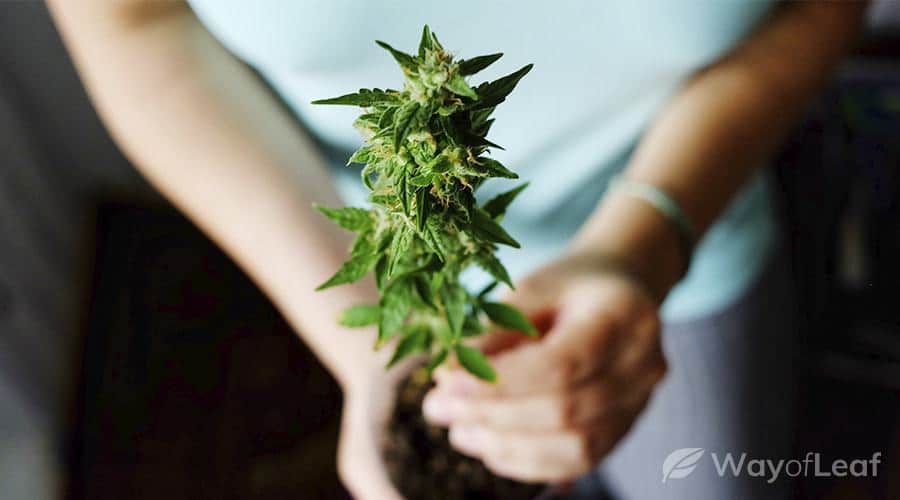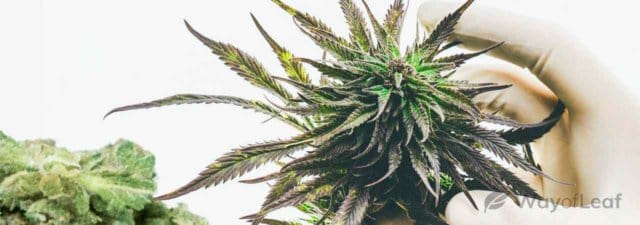This series of articles is dedicated to helping you grow your favorite strain. Today, we provide a growing guide for Grape Ape. It includes eight tips to boost your yield and increase the likelihood of a successful harvest.
Tip #1 – Strain Review and Effects
Here’s a quick overview of the Grape Ape strain to help you decide whether to grow it.
Grape Ape is a heavily indica-dominant (90%) hybrid with a THC content that varies between 15% and 23%. It was developed by Apothecary Genetics and is a cross of Afghani, Skunk, and Mendocino Purps. Grape Ape’s name is due to its grape-like flavor and aroma.
Grape Ape is almost a pure indica, and therefore, its effects make it unsuitable for daytime use.
Bear in mind that Grape Ape is almost a pure indica, and therefore, its effects make it unsuitable for daytime use. Alternatively, users recommend Grape Ape for late evening or nighttime use as it instills a feeling of deep relaxation and sedation.
The body high comes on you fairly quickly and induces couch-lock if you consume too much. Grape Ape lovers say that it is a perfect option after a stressful day.
Tip #2 – Difficulty Growing Grape Ape
Experienced Grape Ape cultivators rate its growth difficulty as moderate. In other words, a bit of skill is required, but novices will be able to get away with a mistake or two. One of the primary issues to watch out for is bud rot, a type of mold that develops in the core of marijuana buds.
The disease begins on the stem inside the bud and spreads out. As a result, it is hard to spot in its early stages. By the time the rot is gray, it is already too late. You need to remove the bud and possibly destroy the plant if it is badly infected.
As far as Grape Ape is concerned, excess humidity and poor ventilation are the leading causes of bud rot. Once your plants start growing in earnest, you will notice how dense the foliage is. It is necessary to trim the lower canopy to promote good circulation throughout the plant. Do this and follow tip #8, which discusses humidity, and you will significantly reduce the risk of bud rot.
Tip #3 – Grape Ape Growing Techniques
If you have some experience growing marijuana, it is perhaps worth trying to grow Grape Ape hydroponically. This method involves using a nutrient-water solution and an inert growing medium such as Rockwool instead of soil. You can begin with a basic setup that enables you to hand-water the pots. If you have a large marijuana garden, a more complex system with timers, pumps, and reservoirs is a better option.
Cannabis cultivators used soil for thousands of years; why change it? That’s an excellent question. Although soil is cannabis’s natural growing medium, some problems are associated with it when growing marijuana indoors, including:
- Risk of pest problems
- A potential inability to recycle the soil
- The need to monitor pH closely
- Difficulty determining how many nutrients are in the soil
Advantages of Growing Cannabis Hydroponically
When you grow hydroponically, you can use small amounts of the growing media. Options such as coco coir can be recycled. You also have total control of nutrient intake and pH level. Having this control will enable you to produce larger, more potent yields when you have enough experience. Moreover, you can use hydroponics in a grow room of any size.
Tip #4 – How to Boost Your Grape Ape Yield
With a moderate to high yield, Grape Ape has some room for improvement. If you are a novice grower, it is easy to underestimate the importance of watering. After all, you just add water to soil or water and nutrients to your inert growing medium, right? In fact, watering technique is one of the most significant issues facing neophyte growers.
Although different environmental considerations alter a watering schedule between an indoor, outdoor, and greenhouse setup, basic irrigation rules apply to all three. Novices, in particular, are often guilty of overwatering their plants. Overwatering causes numerous problems with crucial plant functions, such as root rot and reduced nutrient uptake. It plays havoc with your crop and damages yield.

When growing Grape Ape, make sure the root zones of the plants dry out between watering sessions. A tried-and-trusted way to find out if you are properly watering your plants is to pick up the pot and feel its weight. Soon enough, you will understand how heavy the pot should feel when your crop needs water.
Alternatively, you can invest in a moisture meter that provides an accurate measurement of the root zone’s water retention levels. Individualized soil sensors are even available that offer real-time digital readings of the root zone’s water levels.
Tip #5 – Feeding for Grape Ape
Grape Ape is a marijuana strain that can handle heavier feeding. One tip is to feed compost tea to your crop; it is laden with beneficial nutrients and microorganisms. These microorganisms help boost your crop’s immune system, making it less susceptible to diseases like bud rot and powdery mildew.
Good compost tea will include compost, fish hydrolysate, worm castings, bat guano, molasses, and kelp. You can play around with the ingredients a bit, but compost is an essential addition. Conveniently, there are ready-made compost tea brewers available online, or you can create your own. You’ll need a mesh bag, a 5-gallon bucket, and an air pump, which must be connected to an aerator device.
Although it varies, compost tea takes between 24 and 36 hours to brew. If you allow it to brew for too long, the precious microorganism populations could die. Once you have brewed the tea, make sure you apply it to your growing medium as soon as possible. It’s recommended to do so within 36 hours of being brewed.
Tip #6 – Should You Grow Grape Ape Outdoors or Indoors?
Grape Ape is a versatile strain capable of thriving inside or outside. If you grow outdoors, consider investing in a greenhouse if it is an economically viable option. A greenhouse provides all of the advantages of outdoor growing coupled with shelter from adverse weather conditions.
It is best to use a covered space outdoors to reduce the risk of bud rot mentioned above. If you grow Grape Ape outside, it can yield up to 28 ounces of bud per plant; a vast amount! It is typically ready for harvesting in late September or early October.
Although the yield is lower, Grape Ape is much easier to grow indoors. Due to its dense bud structure and short stature, you can benefit from a decent yield in a small space. Hydroponic growing works well with this marijuana strain because it grows strong and healthy without soil.
However, if you choose hydroponics, remember that you are solely responsible for the crop’s nutrient intake. As such, hydroponic growing is best suited to cultivators with some experience. Overall, Grape Apes grown indoors can provide up to 16 ounces per square meter planted.
Tip #7 – Grape Ape Flowering Time
Generally, Grape Ape’s flowering time is between 7 to 8 weeks. Some strains provide a higher yield if you hold off on harvesting for an extra week. That isn’t the case with this strain. However, if you increase the flowering time to 9 weeks, we recommend reducing the temperature to enhance the flavor.
Grape Ape is a smooth strain with a sweet berry, cherry, and grape flavor. With an extra week of flowering, you can enhance the fruity flavor for a delicious-tasting marijuana strain. However, make sure that less than 80% of the pistils have changed color. Alternatively, check to see that the trichomes have not yet turned amber.
Tip #8 – Best Climate for Growing Grape Ape
Grape Ape plants grow best in daytime temperatures between 68 and 80 degrees Fahrenheit. Bear in mind that this marijuana strain grows dense and thick, so you must keep the relative humidity (RH) levels in the grow room on the low side. It grows well in a warm climate, with the humidity set at 50% during the vegetative stage.
Excess RH does little for this strain’s yield and only increases the risk of mold.
By the time it reaches the flowering stage, you should reduce the humidity level to between 30% and 40%. Once your Grape Ape crop is ready for harvest, the RH should be down at around 30%. Excess RH does little for this strain’s yield and only increases the risk of mold.

![Why Are My Cannabis Leaves Turning Yellow? [Explained]](https://wayofleaf.com/wp-content/uploads/2020/08/wol-banner-why-are-my-cannabis-leaves-turning-yellow-640x225.jpg)



![8 Tips for Growing G13 Marijuana [Grower’s Guide]](https://wayofleaf.com/wp-content/uploads/2019/01/mj_growing-g13-marijuana-640x225.jpg)




![Drying and Curing Cannabis Buds [The Easy Guide]](https://wayofleaf.com/wp-content/uploads/2018/07/drying-and-curing-cannabis-buds-1-640x225.jpg)

